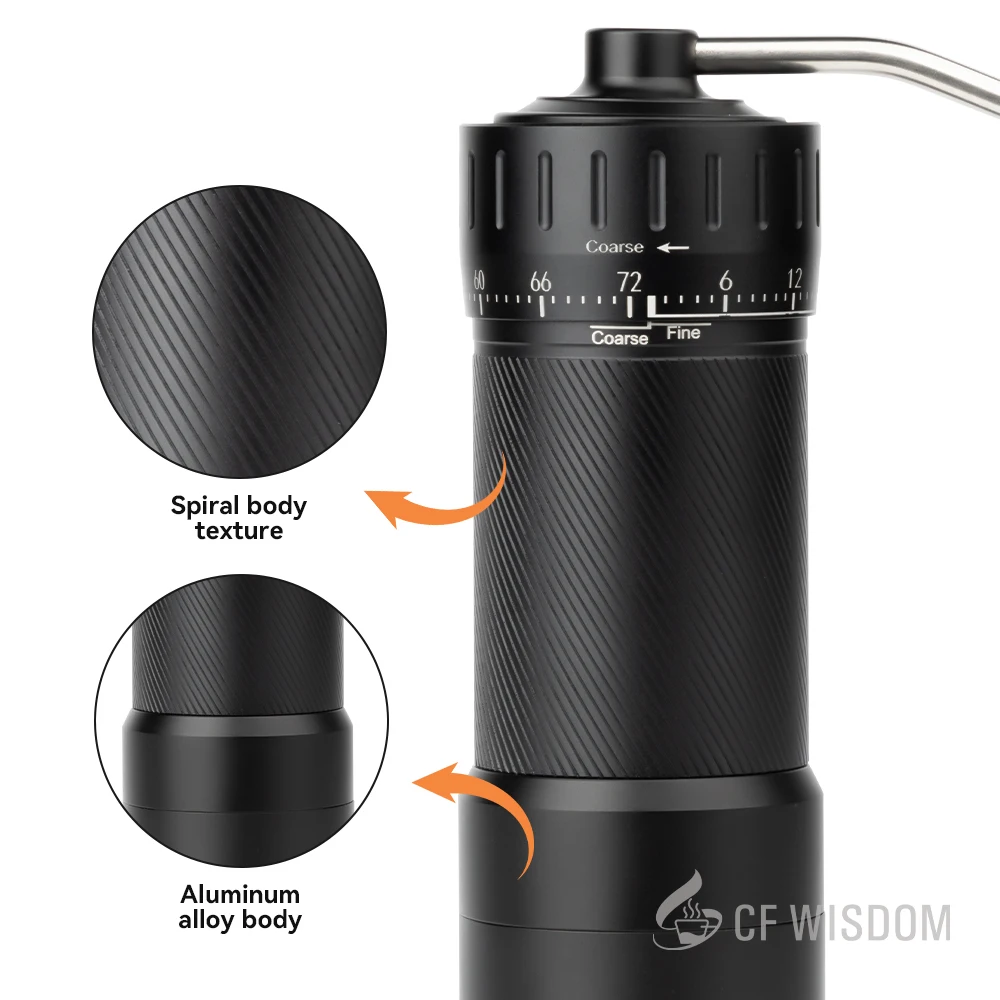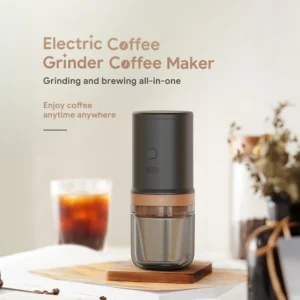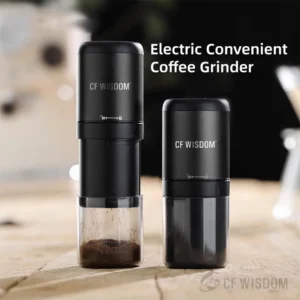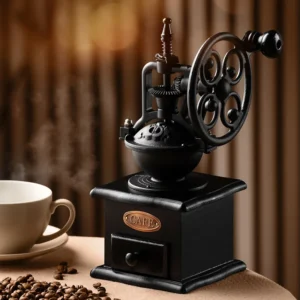Why Every Backpacker Deserves Fresh Ground Coffee
There’s something magical about waking up in the wilderness, unzipping your tent, and breathing in the crisp morning air. Now imagine enhancing that moment with the rich aroma of freshly ground coffee beans. For many outdoor enthusiasts, this simple pleasure makes all the difference between an ordinary backcountry experience and an extraordinary one.
Fresh ground coffee isn’t just a luxury—it’s scientifically superior. Once coffee beans are ground, they begin losing their essential oils and aromatic compounds within minutes. This oxidation process drastically reduces flavor complexity and that vibrant punch we love in a good cup of coffee. Pre-ground coffee exposed to air for just 15 minutes has already lost significant flavor compared to beans ground moments before brewing.
Beyond the flavor benefits, maintaining familiar rituals like grinding coffee beans can provide psychological comfort when you’re miles from civilization. These small ceremonies anchor us and create moments of mindfulness during demanding adventures.
Key benefits include:
– Dramatically improved flavor profile with pronounced notes and aromas
– The satisfaction of a complete brewing process from whole bean to cup
– A morning ritual that centers and prepares you for the day’s journey
– Versatility to adjust your grind size based on your preferred brewing method
– The ability to use your grinder for other trail needs like spices or herbs
Many adventurers who try travel-friendly coffee grinding options never return to pre-ground coffee, despite the slight weight penalty. The sensory reward of that first sip of truly fresh coffee while watching the sunrise over mountain peaks creates memories that last far longer than the extra few ounces in your pack.
Critical Factors to Consider When Choosing a Backpacking Coffee Grinder
Weight and Size
When every ounce matters, your coffee grinder must earn its place in your pack. The lightest options weigh around 8 ounces (227g), while more robust models might reach 12-16 ounces (340-454g). Consider not just the weight but also the shape—cylindrical grinders often pack more efficiently than bulky rectangular designs. The best portable coffee grinders for camping balance minimal weight with sufficient functionality.
Durability Requirements
The trail is unforgiving. Your grinder will face drops, moisture, temperature changes, and constant jostling inside your pack. Materials matter tremendously here—aircraft-grade aluminum, stainless steel, and high-impact plastics will withstand the rigors of backcountry use. Pay special attention to bearing quality and burr attachment methods, as these are common failure points.
Grind Consistency
Inconsistent grinding leads to inconsistent extraction, which means disappointing coffee. This becomes even more critical in the backcountry, where you can’t simply make another cup if the first one tastes off. Quality burr grinders produce uniform particles that extract evenly, while cheaper blade grinders create uneven grounds that lead to bitter or weak coffee.
Ease of Operation and Cleaning
Consider how the grinder operates when you’re cold, tired, or wearing gloves. Are the adjustment mechanisms intuitive? Can you grip it properly with cold hands? Cleaning is equally important—grinders that trap grounds or require tools for maintenance become frustrating liabilities on longer trips. Look for designs with minimal crevices and easy disassembly.
Capacity Needs
Solo adventurers might be satisfied with grinders that process 20-25 grams at once (enough for one to two cups), while group expeditions might require larger capacities of 30-40 grams to avoid multiple grinding sessions. Consider how this balances with your brewing method and group size.
Understanding these essential features of compact coffee grinders will help you make an informed choice that enhances rather than detracts from your wilderness experience.
Top 5 Compact Coffee Grinders for the Trail: Our Expert Reviews
Best Overall Grinder: The Summit Pro Expedition Grinder
The Summit Pro strikes the perfect balance between performance and portability. At just 9.5 ounces (270g) with a sleek cylindrical design measuring 6” × 1.9” (15.2cm × 4.8cm), it slips easily into pack pockets or cooking systems.
Key Specifications:
– Weight: 9.5 oz (270g)
– Materials: Aircraft-grade aluminum body, stainless steel burrs
– Capacity: 30g (enough for two cups)
– Burr Type: 38mm conical, precision-machined stainless steel
Performance Assessment:
The Summit Pro produces remarkably consistent grounds across 15 adjustable settings, from fine espresso to coarse cold brew. The well-designed handle provides excellent leverage, allowing for efficient grinding even after long hiking days when arm fatigue is a factor.
Durability Evaluation:
The sealed bearing assembly prevents moisture intrusion, while the anodized aluminum exterior resists scratches and dents. The burr attachment system uses a unique locking mechanism that prevents loosening during use—a common issue with lesser grinders.
Pros:
– Exceptional grind consistency
– Smooth, efficient grinding action
– Tool-free disassembly for cleaning
– Fits inside most popular camping mugs
– Silent operation (important for dawn brewing in shared campsites)
Cons:
– Premium price point
– Slightly heavier than ultralight options
– Adjustment ring can be difficult to operate with cold hands
Ideal User: The dedicated backcountry coffee enthusiast who refuses to compromise on taste and values reliability over absolute minimum weight.
Most Ultralight Option: The Alpine Minimalist
For through-hikers and ultralight backpackers, the Alpine Minimalist represents the pinnacle of weight reduction without sacrificing fundamental performance.
Key Specifications:
– Weight: 7.1 oz (201g)
– Materials: Reinforced polymer body, ceramic burrs
– Capacity: 20g (single cup)
– Burr Type: 35mm conical ceramic
Performance Assessment:
While grind consistency doesn’t match premium models, the Alpine Minimalist produces entirely acceptable results for pour-over and French press methods most common on the trail. Grinding speed is moderate, requiring about 90 seconds for a full capacity load.
Durability Evaluation:
Despite its lightweight construction, thoughtful engineering protects critical components. The polymer body is surprisingly resilient to drops, though it will show wear faster than metal alternatives. The ceramic burrs maintain their edge longer than steel but are more susceptible to damage from unexpected hard objects (like an occasional small stone in imperfectly processed beans).
Pros:
– Incredibly lightweight
– Surprisingly durable for its weight
– Excellent packability
– Adequate performance for most brewing methods
– Budget-friendly price point
Cons:
– Limited grind size range
– Slightly less consistent grinding
– Smaller capacity requires multiple sessions for group brewing
– Handle provides less leverage than larger models
Ideal User: The gram-counting enthusiast who tracks every ounce but still appreciates the importance of properly ground coffee on long-distance treks.
Most Durable Selection: The Expedition Titanium
When reliability trumps all other concerns, the Expedition Titanium stands as the uncompromising choice for harsh environments and extended adventures.
Key Specifications:
– Weight: 11.8 oz (334g)
– Materials: Titanium body, hardened stainless steel burrs
– Capacity: 35g (2-3 cups)
– Burr Type: 40mm conical steel, treated for hardness
Performance Assessment:
The Expedition delivers exceptional grind consistency comparable to home grinders, with 25 distinct adjustment settings. The substantial handle and optimized burr design reduce grinding effort, though the extra weight is noticeable.
Durability Evaluation:
Nearly indestructible. The titanium body withstands crushing forces, extreme temperatures, and careless handling. Waterproof seals protect the precision bearings, while the burr assembly uses a proprietary locking system that prevents vibration-induced loosening even after months on the trail.
Pros:
– Virtually bombproof construction
– Excellent grinding performance
– 10-year warranty (unprecedented in portable grinders)
– Stable base design prevents tipping during grinding
– High capacity for group trips
Cons:
– Heaviest option in our lineup
– Premium price point
– Slightly larger packed size
– Overkill for weekend warriors
Ideal User: Expedition leaders, professional guides, and adventurers undertaking remote, extended journeys where equipment failure is not an option.
Best Budget-Friendly Pick: The Trailhead Classic
Not every backpacker needs or wants to invest heavily in a specialty coffee grinder. The Trailhead Classic delivers satisfying performance without breaking the bank.
Key Specifications:
– Weight: 9.7 oz (275g)
– Materials: Polycarbonate body, stainless steel burrs
– Capacity: 25g (1-2 cups)
– Burr Type: 36mm conical steel
Performance Assessment:
Grind consistency is quite good for the price point, especially in the medium to coarse range most suitable for trail brewing methods. The grinding action requires more effort than premium models but remains manageable for daily use.
Durability Evaluation:
While not as rugged as top-tier options, the Trailhead’s construction stands up well to typical trail conditions. The polycarbonate body resists impacts but will show wear and may crack under severe stress. The burr assembly is surprisingly well-engineered for the price point, though the adjustment mechanism is less precise than more expensive competitors.
Pros:
– Excellent value proposition
– Good performance for French press and pour-over methods
– Lightweight for its capability
– Easy to clean with smooth interior surfaces
Cons:
– Less precise grind adjustments
– More plastic components than premium options
– Handle comfort decreases during extended grinding sessions
– Less consistent with very fine grinds
Ideal User: Weekend backpackers, those new to trail coffee, or experienced hikers who need a capable grinder without premium pricing.
Best Grinder for AeroPress Users: The Precision Alpine
AeroPress has become the go-to brewing method for many serious backcountry coffee enthusiasts thanks to its lightweight, durable design and excellent results. The Precision Alpine is specifically optimized for this popular brewer.
Key Specifications:
– Weight: 8.9 oz (252g)
– Materials: Aluminum body, steel/ceramic hybrid burrs
– Capacity: 25g (perfect for AeroPress brewing)
– Burr Type: 38mm conical hybrid
Performance Assessment:
The Precision Alpine excels at the medium-fine grind size perfect for AeroPress brewing. Its innovative hybrid burrs create the ideal particle distribution for this method, resulting in noticeably improved extraction and flavor. The grinding action is smooth and requires minimal effort.
Durability Evaluation:
Very good overall durability with special attention to the burr assembly, which maintains alignment even after significant use. The aluminum body resists most trail hazards, though it’s not quite as robust as premium titanium or steel options.
Pros:
– Optimized specifically for AeroPress brewing
– Exceptionally clean cup flavor
– Ergonomic grip design
– Fits perfectly inside the AeroPress plunger for packing
– Includes specialized micro-adjustments for dialing in AeroPress recipes
Cons:
– Less versatile for other brewing methods
– Mid-range price point
– Fewer grind size options for very coarse settings
– Specialized design feels less intuitive for beginners
Ideal User: Dedicated AeroPress enthusiasts who want to maximize their backcountry brewing experience with grind quality specifically tailored to their preferred method.
Many avid travelers appreciate how the best hand grinders for travel brewing can transform an ordinary outdoor trip into a gourmet experience. Our selection in the travel coffee grinder category offers options for every type of backpacker.
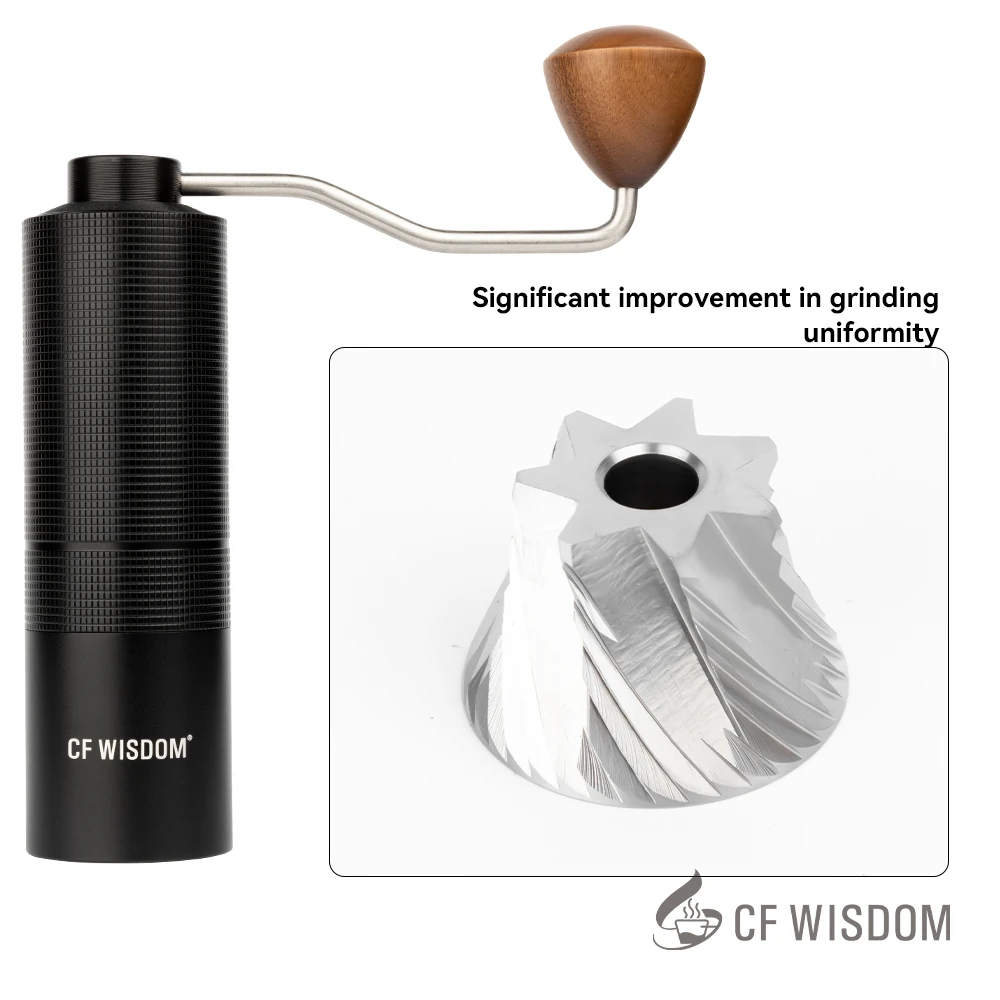
Understanding Burr Types for Outdoor Coffee Grinding
The burr system is the heart of any quality coffee grinder, and understanding the differences becomes particularly important for backcountry use where conditions are far from ideal. Two main distinctions impact your wilderness coffee experience: burr shape (conical vs. flat) and material (ceramic vs. stainless steel).
Conical vs. Flat Burrs
Conical burrs feature a cone-shaped center burr that rotates against an outer serrated ring. This design excels in portable grinders because it:
– Requires less horizontal space, allowing for slimmer, more packable designs
– Generates less heat during grinding, preserving delicate flavor compounds
– Typically demands less physical effort, a significant advantage on the trail
Flat burrs, with their parallel grinding surfaces, generally produce more consistent grounds but require more torque and space—making them rare in backpacking grinders.
Ceramic vs. Stainless Steel Material Comparison
| Characteristic | Ceramic Burrs | Stainless Steel Burrs |
|---|---|---|
| Weight | Lighter | Heavier |
| Durability | Brittle (can chip/break) | Impact resistant |
| Edge Retention | Excellent (stays sharp longer) | Good (dulls gradually) |
| Temperature Stability | Superior (no expansion) | Can expand slightly with heat |
| Cold Weather Performance | Unchanged | Can contract slightly |
| Performance with Oily Beans | Can clog more easily | Better with oily dark roasts |
| Cleaning Requirements | More frequent | Less demanding |
| Typical Lifespan | Longer if not damaged | Slightly shorter but more reliable |
For backpackers, steel burrs typically offer the best balance of durability and performance. Their resistance to impact damage outweighs the slight edge-retention advantage of ceramic in most wilderness scenarios. However, ultralight enthusiasts might prefer ceramic for the weight savings, especially if they’re careful with their equipment.
Different burr designs also perform differently with various coffee roast levels. Lighter roasts are denser and more difficult to grind, often benefiting from sharper ceramic burrs. Darker roasts produce more oils that can clog ceramic burrs more readily than steel versions.
The most lightweight hand grinders for camping typically feature carefully engineered burr systems that balance weight against performance. For a variety of options, our portable coffee grinder collection includes models with different burr configurations to meet various needs.
Field Maintenance: Keeping Your Grinder Clean on the Trail
Maintaining your grinder in the backcountry preserves both coffee quality and equipment longevity. With limited resources available, these techniques will keep your grinder performing optimally:
Quick Daily Cleaning
- The Tap Method: After grinding, tap the disassembled grinder firmly against your palm to dislodge most grounds
- Brush Cleaning: A small brush (even a clean toothbrush) can reach crevices where grounds collect
- Bread Technique: In extremely dry environments, a small piece of bread can absorb oils and collect fine particles when run through the grinder
- Coffee Sacrificing: Grinding a few beans and discarding them can help clean the burrs of oils from previous uses
Dealing with Static in Dry Environments
- Add 1-2 drops of water to your beans before grinding (the “Ross Droplet Technique”)
- Wait 30-60 seconds after grinding before opening the catch cup to allow static to dissipate
- In extremely dry conditions, briefly touch the metal components with a grounded object
Preventing Oil Buildup on Extended Trips
- Disassemble your grinder every 3-5 days for thorough cleaning
- Use bandana corners slightly dampened with water to wipe down accessible parts
- Focus particular attention on the burr grooves where oils accumulate
- Allow components to completely air dry before reassembly
Disassembly and Reassembly
- Always document the order of components before complete disassembly
- Store tiny screws and springs in a secure container like a mini ziplock bag
- Check adjustment mechanisms for debris that affects grind settings
- Ensure burrs are properly aligned during reassembly
Troubleshooting Common Issues
- Seized Mechanisms: Apply gentle pressure while rotating components back and forth
- Stuck Beans: A gentle tap against a tree or rock often dislodges caught beans
- Inconsistent Grinding: Check for debris between burrs or loose components
- Increasing Resistance: Likely indicates oil buildup requiring deeper cleaning
Understanding whether coffee grinders need maintenance is critical for wilderness use, where performance issues can’t be easily resolved by purchasing a replacement.
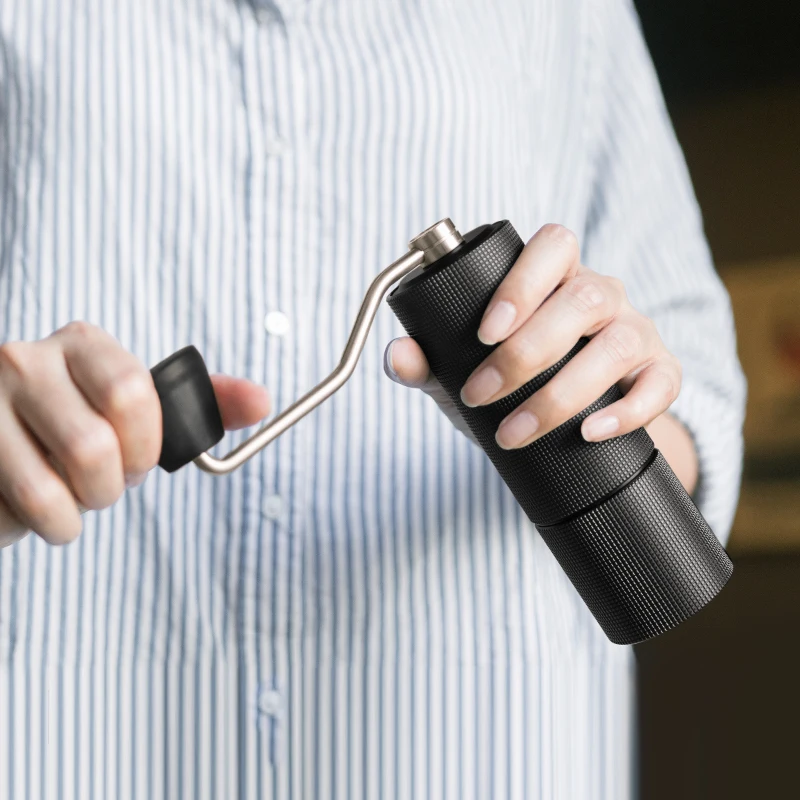
Maximizing Space: Storage and Packing Strategies
Efficient packing is fundamental to successful backpacking, and your coffee grinder needs to integrate seamlessly into your system to justify its place in your pack.
Nesting Techniques
- Many cylindrical grinders fit perfectly inside standard cooking pots
- Some models are specifically designed to nest inside popular brewing devices like the AeroPress
- Remove handles and store them alongside the grinder body to create a more packable shape
- Use soft items like socks or buff headwear to prevent metal-on-metal contact when nesting
Multi-Purpose Storage
- Use your grinder’s bean chamber to store pre-measured coffee doses for quick access
- Some grinders can safely store other small items when not in use (spice containers, tea bags)
- Waterproof grinders can double as small dry containers for matches or electronics
Protection Strategies
- Store grinders in the center of your pack, surrounded by soft items
- For grinders with glass components, wrap in a small piece of foam sleeping pad
- Consider using a dedicated soft case for grinders with exposed adjustment mechanisms
- Keep adjustment tools (if required) in a small bag attached to the grinder
Weight Distribution
- Position your grinder near the middle of your pack, close to your back for optimal balance
- If using a heavy metal grinder, place it slightly lower in the pack to maintain your center of gravity
- For ultralight setups, consider whether your grinder can replace another container item to offset its weight
Our selection of compact coffee mills includes models specifically designed with efficient packing in mind.
Fine Adjustment Hand Grinder, Precision Manual Grinder, Travel Coffee Grinder
Price range: $185.11 through $494.63 Select options This product has multiple variants. The options may be chosen on the product pageHand Burr Grinder, Hand Crank Coffee Grinder, Manual Espresso Grinder, Portable Coffee Grinder
Price range: $262.72 through $300.22 Select options This product has multiple variants. The options may be chosen on the product pageHandheld Burr Grinder, Manual Coffee Mill Grinder, Travel Coffee Grinder
$191.45 Select options This product has multiple variants. The options may be chosen on the product pageManual Coffee Grinder Stainless Steel, Manual Espresso Grinder, Travel Coffee Grinder
Price range: $276.22 through $276.39 Select options This product has multiple variants. The options may be chosen on the product pageHand Crank Coffee Grinder, Handheld Coffee Grinder, Manual Coffee Bean Grinder
$138.38 Select options This product has multiple variants. The options may be chosen on the product page
Beyond Coffee: Multi-Purpose Uses for Your Compact Grinder
Getting maximum utility from every item in your pack helps justify the weight. Your quality coffee grinder can serve multiple purposes beyond its primary function:
Trail Spices and Seasonings
- Grind whole dried spices for fresher, more potent flavors in camp meals
- Create custom spice blends before grinding for unique meal enhancement
- Process salt crystals or sugar cubes into finer textures for even distribution in cooking
Dried Herbs and Tea
- Break down dried herbs like oregano, thyme, or basil for cooking
- Process loose-leaf tea to a consistent size for better extraction
- Create custom tea blends from foraged ingredients like mint or spruce tips
Foraging Applications
- Grind dry wild seeds for inclusion in trail breads or pancakes
- Process foraged nuts into coarse meal for adding to oatmeal or yogurt
- Break down dried berries into flavorful powder for beverages
Other Creative Uses
- Convert rolled oats into a finer texture for smoother porridge
- Process dehydrated vegetables into powder for instant soup bases
- Create homemade spice rubs from whole ingredients for trail-side grilling
Important Maintenance Note: Always thoroughly clean your grinder when switching between coffee and other substances. Run white rice through the grinder to absorb flavors and oils before returning to coffee use.
For many outdoor enthusiasts, manual coffee grinders for portable perfection provide not only excellent coffee but also versatility that electric alternatives simply cannot match.
Frequently Asked Questions About Backpacking with Coffee Grinders
Is a coffee grinder worth the extra weight in my pack?
For trips shorter than 3-4 days, pre-grinding your coffee immediately before departure offers a reasonable compromise. For longer journeys, a grinder becomes increasingly valuable as the flavor difference becomes more noticeable with each passing day. For many backpackers, the 8-12 ounces is justified by the significant improvement in their morning ritual.
Can compact grinders achieve fine enough grinds for espresso-style brewing?
The best portable burr grinders can produce grinds fine enough for pressurized brewing methods like AeroPress with Fellow Prismo attachment or portable espresso makers. However, they typically cannot achieve the extremely fine, consistent grind required for traditional espresso machines. For backcountry use, slightly coarser grinds than ideal often work adequately in portable pressure brewers.
How much longer does the morning routine take when grinding fresh?
Hand-grinding adds approximately 1-2 minutes to your morning routine for a single cup, depending on the grinder efficiency and bean quantity. Many backpackers incorporate this into their water-heating time, grinding while waiting for water to boil.
What’s the most durable grinder for extended international backpacking?
Full metal construction with sealed bearings offers the best durability for unpredictable conditions. Models with minimal plastic components, especially in the burr attachment system, will withstand rough transport and variable environmental conditions. Look specifically for grinders featuring steel burrs, metal adjustment mechanisms, and waterproof seals.
Can I reasonably clean a grinder without soap and abundant water?
Yes, most trail cleaning can be accomplished without soap. Disassemble the grinder to the extent possible, use a bandana or small brush to remove grounds, and allow components to air dry completely. For deeper cleaning, small amounts of water focused on the burrs themselves is typically sufficient. A final run with white rice or a few sacrificial beans helps absorb any remaining moisture.
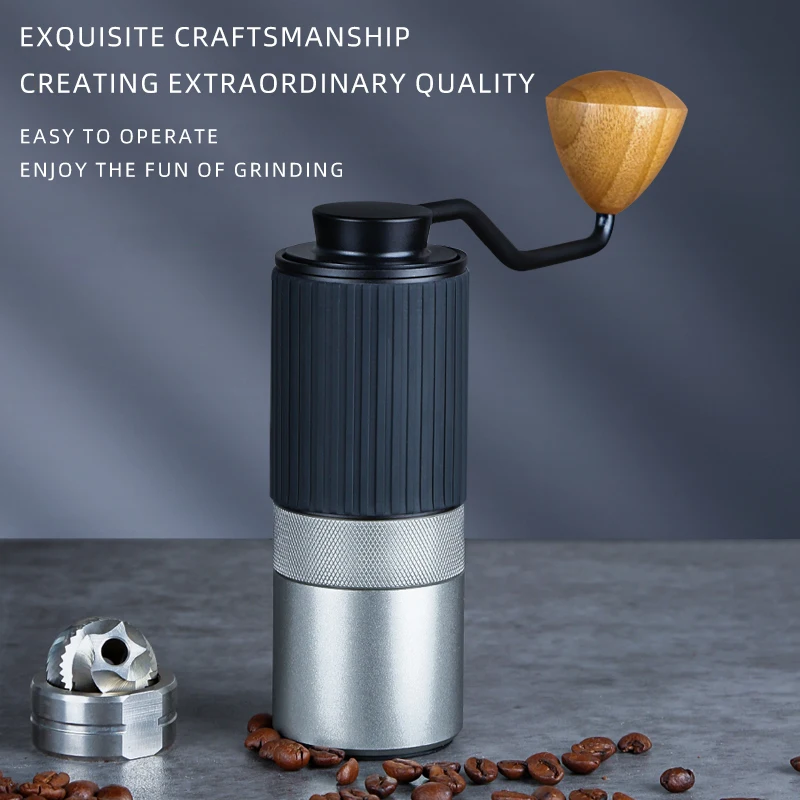
Our extensive collection of handheld coffee grinders includes options perfectly suited for various backcountry scenarios.
Conclusion: Elevating Your Backcountry Coffee Experience
The morning ritual of grinding coffee beans beside an alpine lake or under the canopy of an old-growth forest connects us to our surroundings in a way that tearing open a pre-ground packet simply cannot match. While a quality grinder does add weight to your pack, the sensory rewards and enhanced outdoor experience make it a worthwhile consideration for many backpackers.
Whether you prioritize absolute minimum weight, maximum durability, or optimal grinding performance, today’s portable grinders offer solutions for every backcountry coffee enthusiast. The best choice depends on your personal brewing method, trip duration, and how central quality coffee is to your outdoor experience.
Remember that the perfect cup isn’t just about taste—it’s about creating moments of simple luxury in wild places. There’s profound satisfaction in transforming whole beans into the perfect grind while surrounded by nature’s grandeur. Our selection of portable coffee hand grinders helps make those moments possible, no matter how far from civilization your adventures take you.

